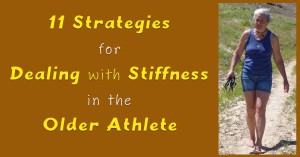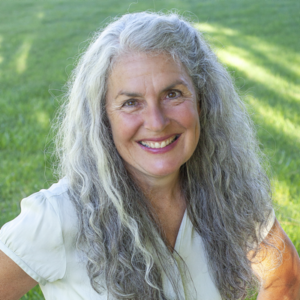What is ROM?
Ever since the teenage me took care of the twisted bodies of nursing home patients, I have been concerned about getting stiff as I age. I remember one dear woman who had been bedridden for many years. If I remember correctly, she was in her nineties. Although her chart detailed a normal life, at that point she non-communicative EXCEPT when we had to move her. Any movement seemed to be agonizing to her, because every joint seemed to be frozen.
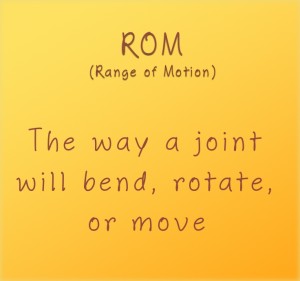 A joint is called frozen when it will no longer move, bend, rotate, or go through whatever motion it is supposed to enable (this is referred to as “range of motion” or ROM). The joint then might as well be completely bone. Once a joint has been frozen for a while, it is just about impossible to get it to move again without some drastic measures. Like when my husband’s shoulder joint got too stiff after surgery and the doctor had to perform surgery again just to cut away scar tissue.
A joint is called frozen when it will no longer move, bend, rotate, or go through whatever motion it is supposed to enable (this is referred to as “range of motion” or ROM). The joint then might as well be completely bone. Once a joint has been frozen for a while, it is just about impossible to get it to move again without some drastic measures. Like when my husband’s shoulder joint got too stiff after surgery and the doctor had to perform surgery again just to cut away scar tissue.
The trouble with frozen joints
In nurse’s training, we are taught to help avoid such frozen joints by at least putting a patient’s joints through passive range of motion, if they are not able to do it themselves. Being young and inexperienced at the time I was working in the nursing home, I simply tried to follow that protocol on that poor, helpless woman. I had her best interests in mind, but I finally gave up because she was obviously in so much pain when I tried to do something as simple as move her ankle. Her moans have lodged themselves in my memory.
When I broke my cheek bone a few years ago (bicycle accident), my jaw became very stiff. I was not allowed to move it while it was healing for 8 weeks. After that, I had to do stretching exercises several times a day for several weeks to be able to open my mouth again. The progress was so slow as to make the exercises seem ineffective on any given day, but finally my mouth could open fully again. I have wondered what life would be like if I had waited too long to do that motion. (click on any image to enlarge)
Common exercise induced stiffness versus aging
Over the years, I have had what I would call normal exercise stiffness. After an unusually intense or prolonged effort, I would be sore, but it always went away over time. Sometimes hot bathes and massaging could make it feel better sooner, but even without that, it would go away sooner or later.
Just a couple of years ago, that started to change. I began noticing that I woke up stiff on a regular basis. It certainly wasn’t because I was being inactive or limiting the scope of my movements during the day. I was still running, biking, swimming, gardening, and dancing the same as I had been before. Only now, the degree of exercise effort was sometimes hard to distinguish from this new perennial stiffness.
When I had my final hormone shift, the stiffness seemed to want to set in with a new tenaciousness. From that time on, I would tend to get stiff if I sat anywhere or didn’t move for very long. I decided that while I may have to learn to live with being older, that didn’t mean I couldn’t come up with strategies for staying as un-stiff as possible. I began experimenting.
Strategies for minimum stiffness
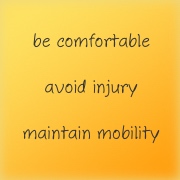 I have now come up with a basic approach to minimalizing and/or combatting stiffness. The idea is to
I have now come up with a basic approach to minimalizing and/or combatting stiffness. The idea is to
- be comfortable
- avoid injury
- maintain mobility
Here is what I do:
- Consciously contract and flex major muscle groups in my body before getting out of bed, or after prolonged period of inactivity.
- Change positions regularly throughout the day.
- Plan movements to engage a full range of movements.
- Use body parts the way they were designed to be used.
- Avoid devices and clothing that are supposed to “support” body parts, but really hinder designed ROM. This could include anything from stiff footwear to figure shapers.
- Stay warm.
- Keep blood circulating well to my extremities, which involves both staying reasonably warm and moving body parts.
- At the beginning of an activity, start out more slowly and let the motions warm up my muscles.
- Be patient with my various fitness activities.
- Get a massage regularly.
- Make sure to eat enough salt.
What about stretching?
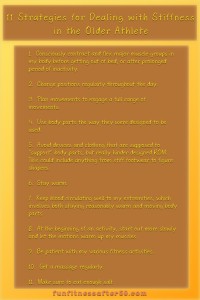 I am leery of stretching for the sake of stretching, as I think there is a risk of tearing musculature if it is not warmed up the way only activity can warm it up. I have also found that motion ends up increasing my flexibility better than plain stretching. For example, I have tried basic pre-activity stretching for many years when I was younger. The results were minimal. So imagine my surprise when after about 3 years of going out dancing just once a month or so (after the age of 50!) that my overall flexibility increased dramatically!
I am leery of stretching for the sake of stretching, as I think there is a risk of tearing musculature if it is not warmed up the way only activity can warm it up. I have also found that motion ends up increasing my flexibility better than plain stretching. For example, I have tried basic pre-activity stretching for many years when I was younger. The results were minimal. So imagine my surprise when after about 3 years of going out dancing just once a month or so (after the age of 50!) that my overall flexibility increased dramatically!
Does exercise reduce overall stiffness due to aging?
I haven’t changed my exercise efforts or routine significantly in the past 7 years of so, so I can’t say that more exercise reduced overall stiffness for me. However, from watching and listening to other people around my age or older, I can reasonably conclude that it doesn’t make it worse. What I do know for certain is that I always feel looser after I have exercised and I don’t feel as much stiffness during the day if I am active throughout the day. Also, my 20something daughters tell me I have a spring in my step that they don’t see in other people my age.
By “active throughout the day” I mean “moving regularly”. Ideally this will include a range of intensities, from regular aerobic exercise to walking around the house to do chores. Some days are still more restful and sit-down than others, and then I try to do ROM intermittently.
I know there is some debate about whether or not exercise makes people healthy or that healthy people exercise; but it seems clear that how much a person moves still makes a difference in endurance and capabilities, no matter how basically healthy he or she is. It seems reasonable that this is also true with staying limber and my experience seems to verify this.
